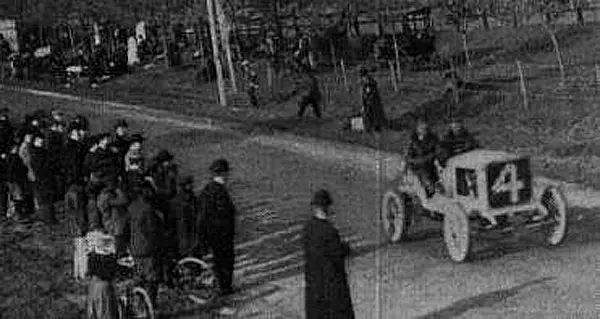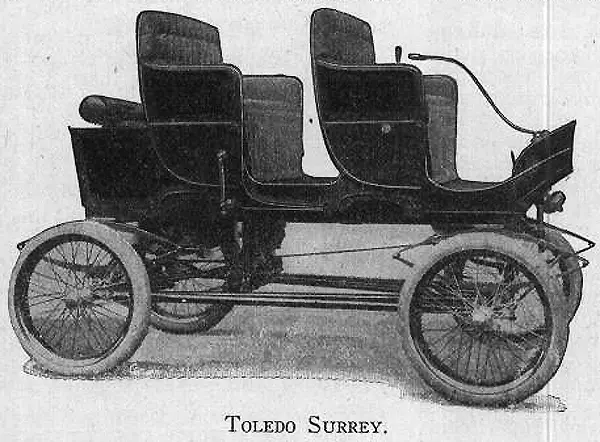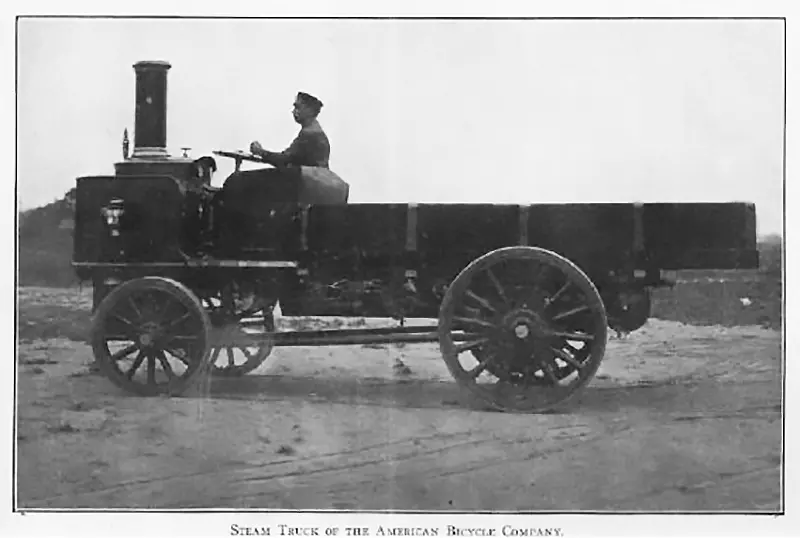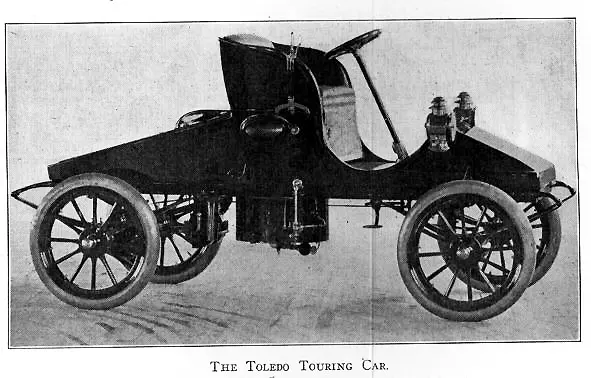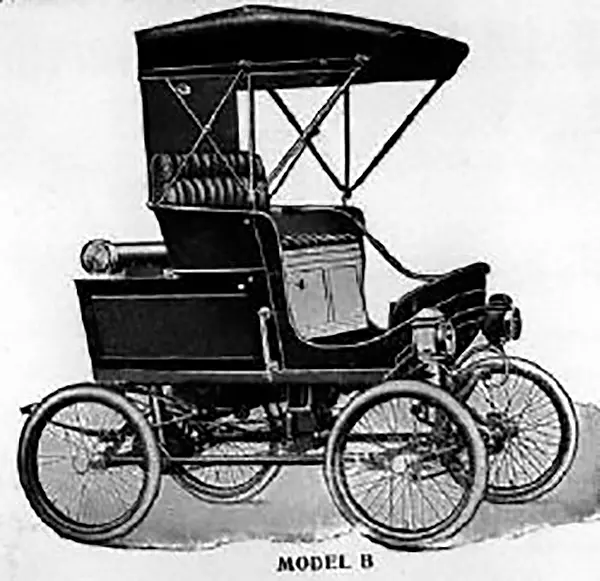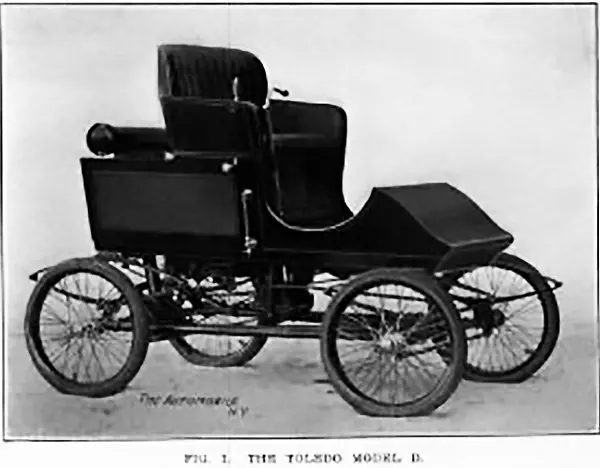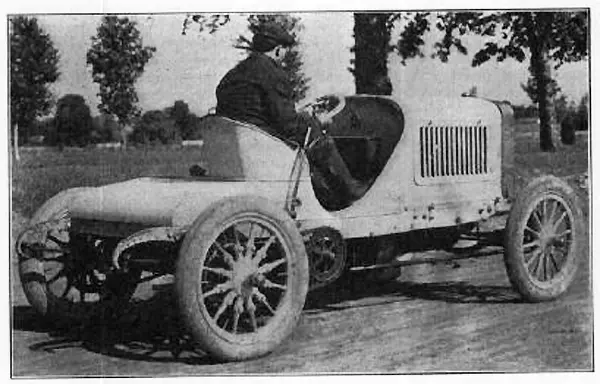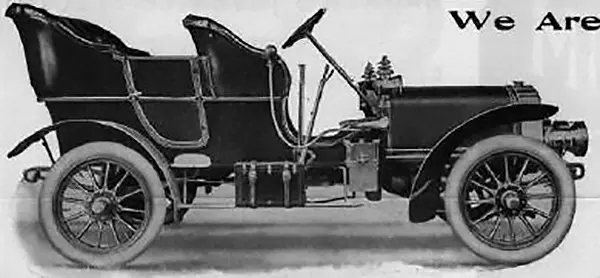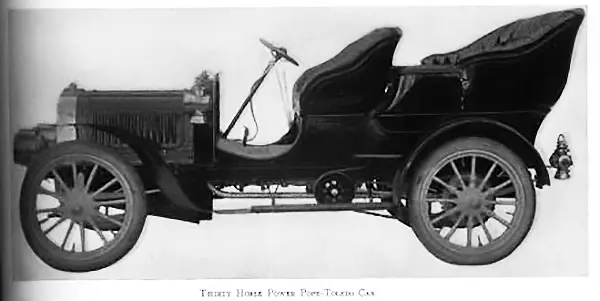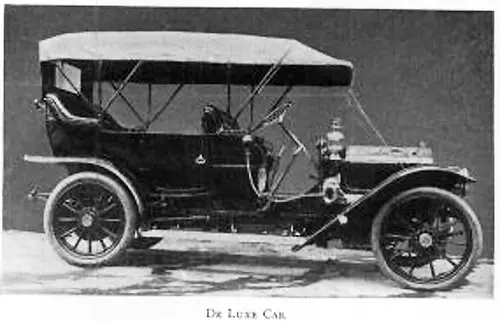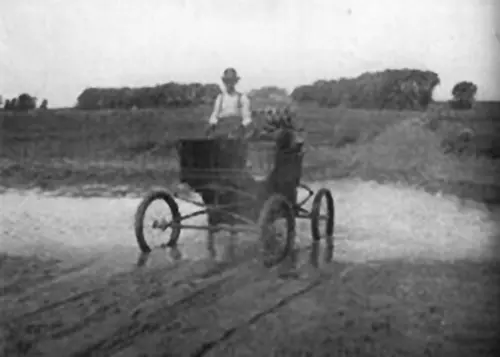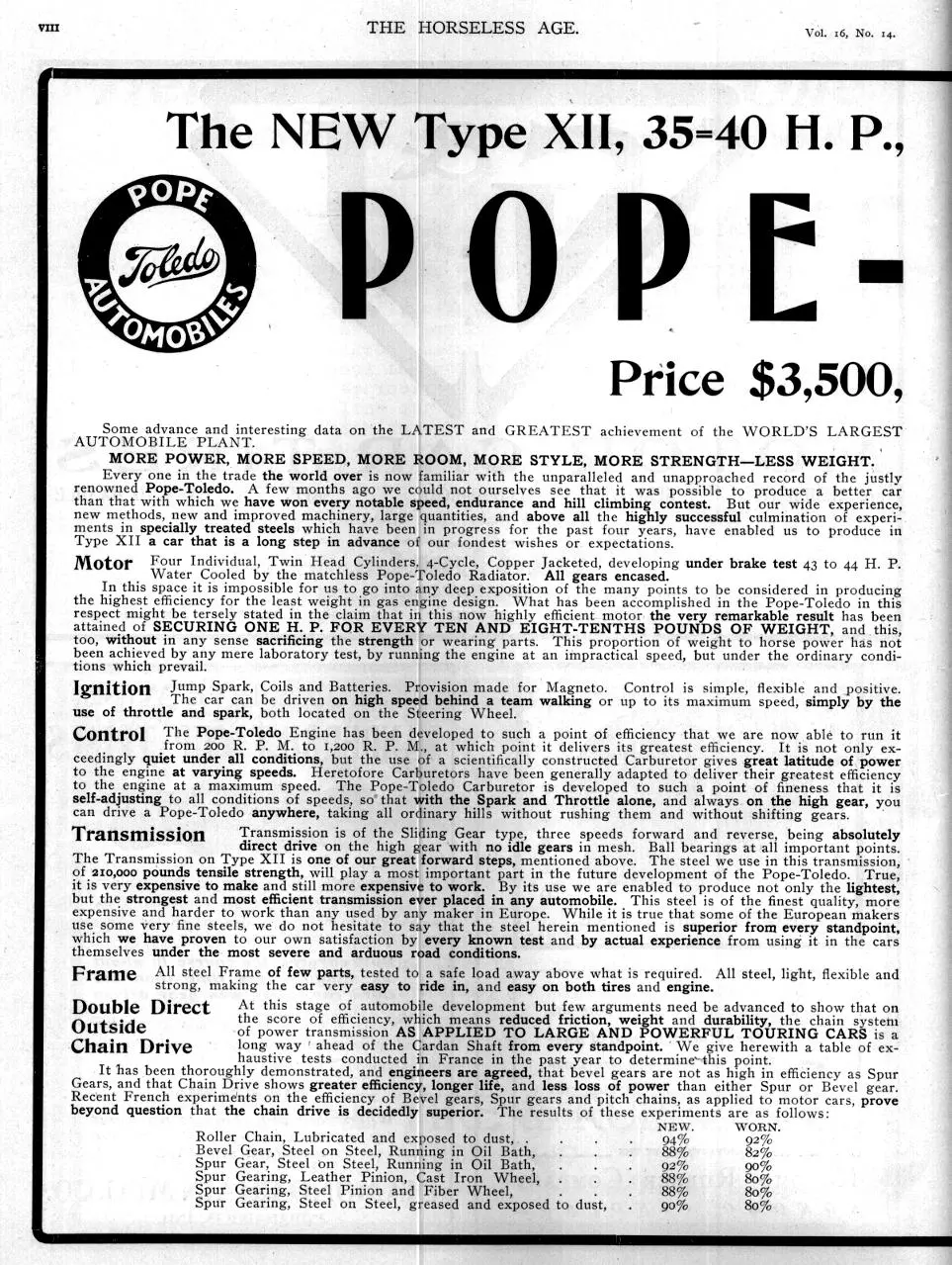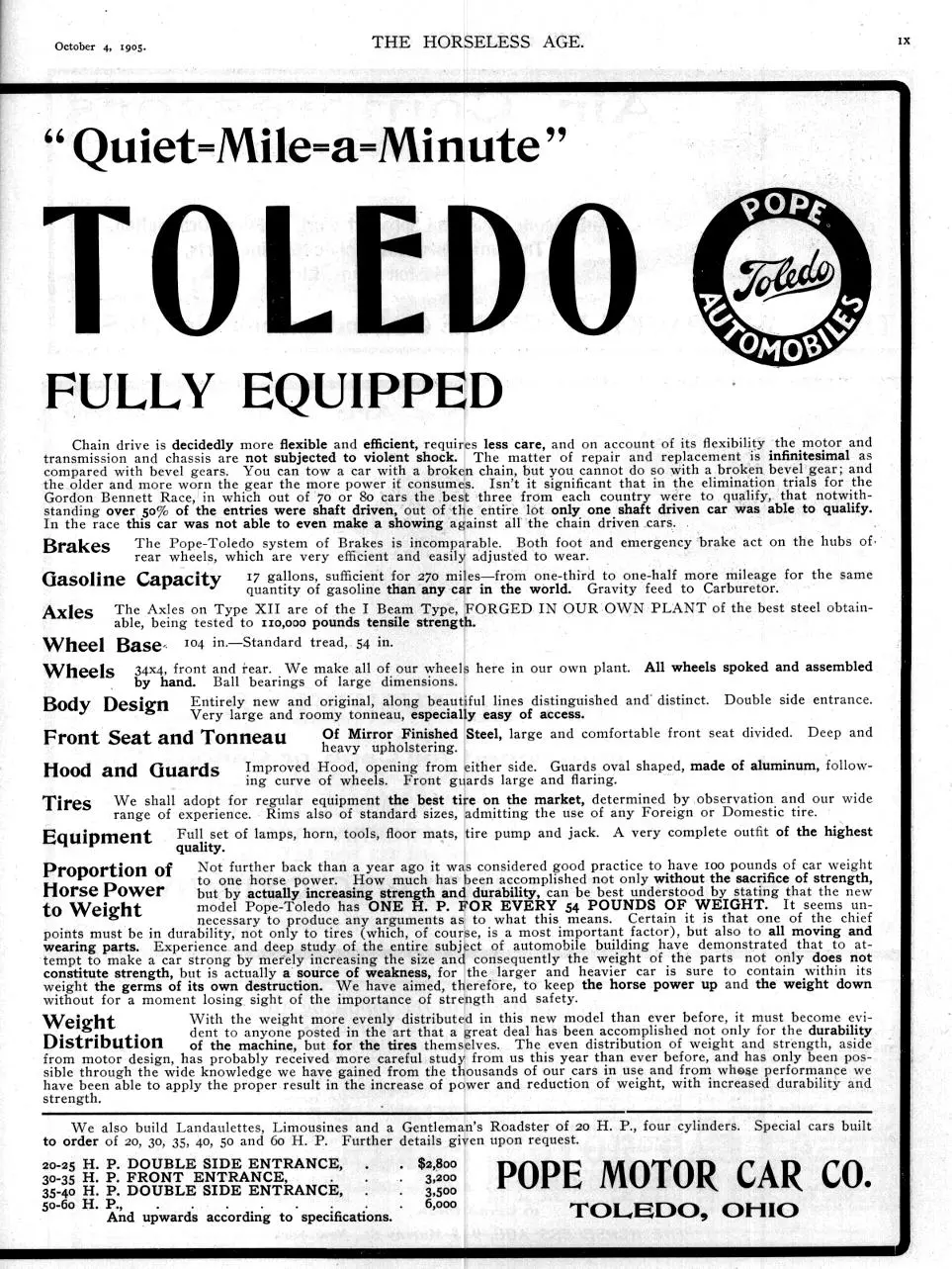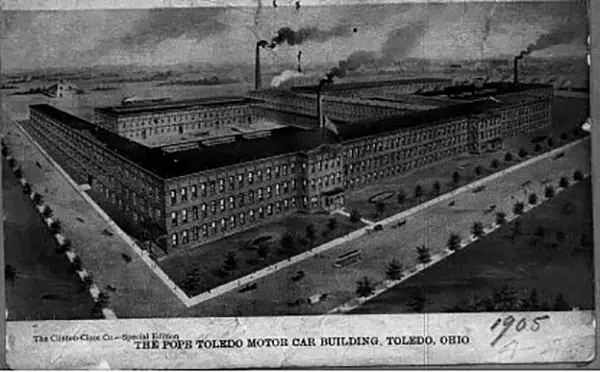 The Pope Toledo Motor Car Building, Toledo, Ohio, 1905
The Pope Toledo Motor Car Building, Toledo, Ohio, 1905
Exhibit Gallery
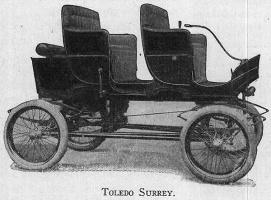

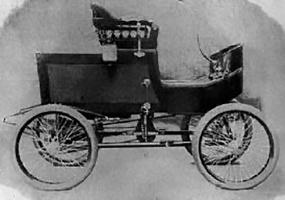

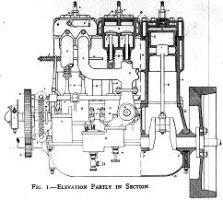
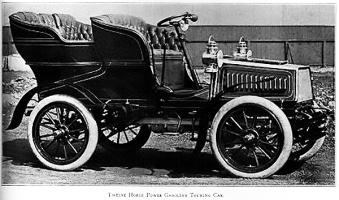
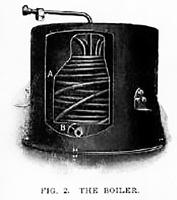
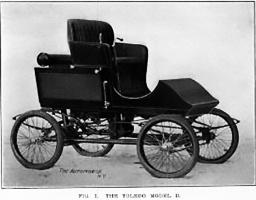
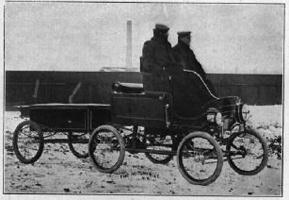
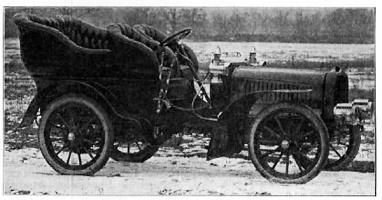
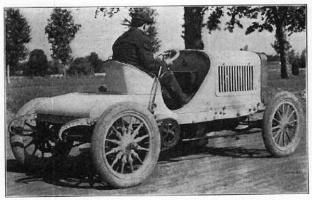
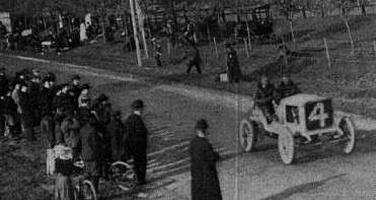
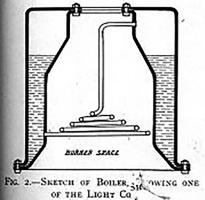

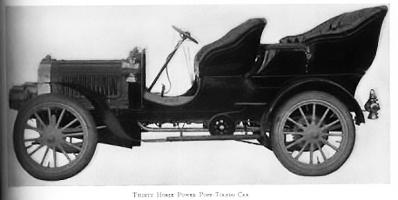
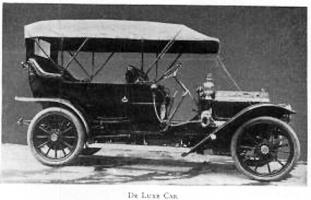
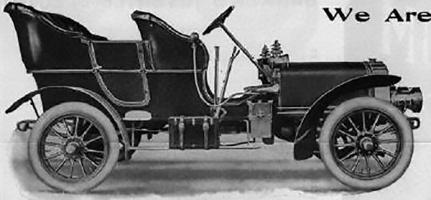

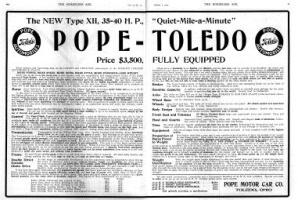
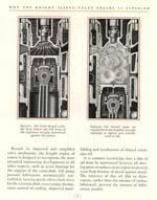
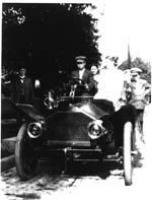
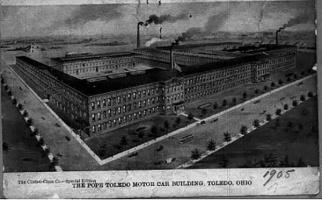
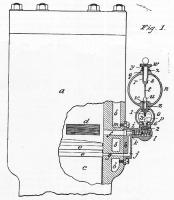







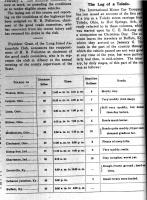

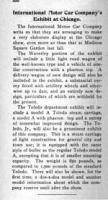




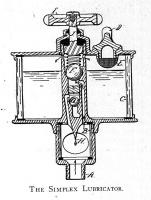








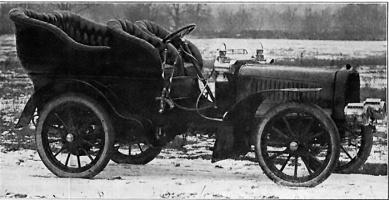






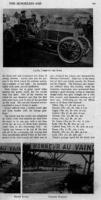




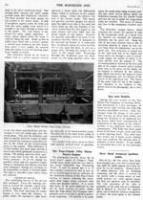




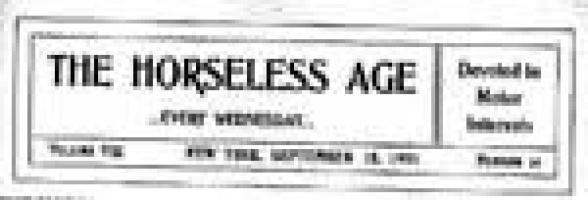

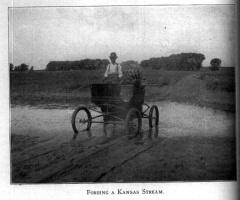




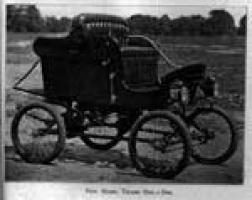




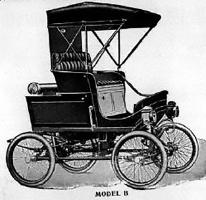




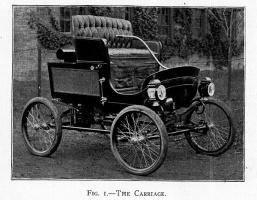
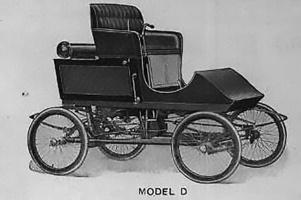
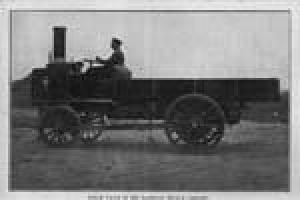
by Timothy Messer-Kruse, December 1999
The Pope Toledo Motor Car Building, Toledo, Ohio, 1905
Toledo has had a long and continuous automotive history. For Toledo, the year 2000 will not only mark the great roll-over of the millennial odometer, but will also be the centennial year of automobile production in the city. In the fall of 1900, the American Bicycle Company built a steam truck in a factory on Central Avenue. From that time with only a few interruptions, notably in the panic of 1907 and the Great Depression, automobiles and trucks have been built upon this same site to the present day.
Toledo's automobile industry had humble beginnings. A number of tinkerers began working on horseless carriages in the late 1890s. In 1898, a Toledo plumber by the name of A.E. Lecklider began construction of an automobile in his spare time. He completed it in 1902 but saw it destroyed by fire the following year. In 1899, George Burwell, superintendent of the Lozier Bicycle factory, designed a 3 wheeled gasoline car with John G. Perrin, though it is not known if the contraption was ever made. Burwell would be the first Toledoan to patent an automobile part when his engine cylinder lubricator was recognized in September of 1900 [open]. A Toledo bicycle company, Kirk Manufacturing, announced that it was working on an automobile in 1899. Another inventor, Alfred Thompson, patented an automobile design in 1901 [open]. Though no automobiles were actually built in Toledo until late in 1900, a number of them were seen on the streets before then (Peter Gendron drove one in 1899).
In May of 1900, Toledoans were disappointed to learn that the Lozier Motor Company, a maker of bicycles and marine motors, was leaving Toledo and moving to New York state. After several months of negotiations, the American Bicycle Company (ABC), one of the many companies owned by the Hartford, Connecticut industrialist Albert Pope, purchased the Lozier factory lock, stock and barrel. Pope was just beginning to diversify into the infant automotive industry and began gobbling up auto patents and properties. In addition to the Lozier properties, Pope purchased an electric automobile plant in Massachusetts.
ABC wasted no time in tooling up its Toledo plant and sometime before December of 1900, it built a 925-pound, two-seat steam carriage. Reflecting the industrial base of the city and company that built it, the steamer incorporated many features of the bicycle (over the previous decade, Toledo had been one of the largest producers of bicycles and bicycle parts in the nation). Toledo Steamers sported bicycle spoke wheels and bicycle tube frames, making them easy to spot from a distance in a faded photograph. By February of 1901, ABC was advertising its little Steamer for sale around the country.
At the time, most automobiles were powered by steam or electricity. Internal combustion was a far trickier technology in those early years as combustion engines were more expensive, less reliable, and more prone to breakdowns. Steamers worked by burning gasoline or kerosene to boil water. The resulting steam pushed one or two pistons that cranked a belt or chain drive to the rear wheels.
Toledo's Steamers boasted an improved boiler that was more efficient and used less gasoline. But like electric cars, Steamers’ prospects were doomed by their limited range. Electrics needed a new charge after fifty or sixty miles, and Steamers needed to replenish their water supply. Even Toledo's better boilers sucked a gallon of water for every mile traveled. The Toledo Steamer’s 35-gallon gas tank and 9.5- gallon gas tank could only propel the little carriage 36 miles.
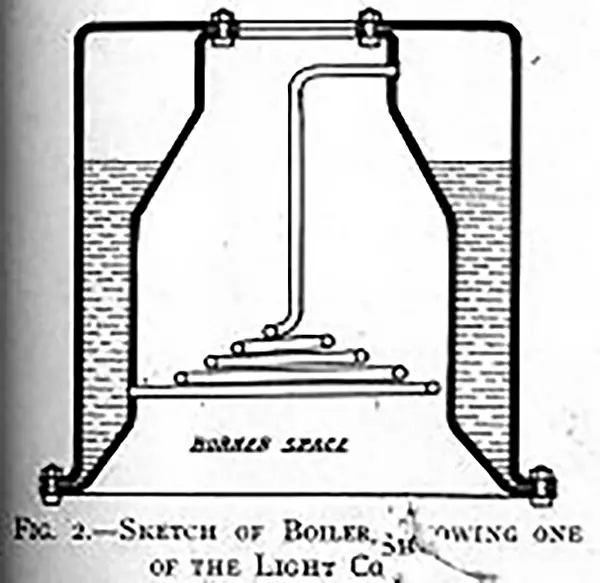 Sketch of boiler
Sketch of boiler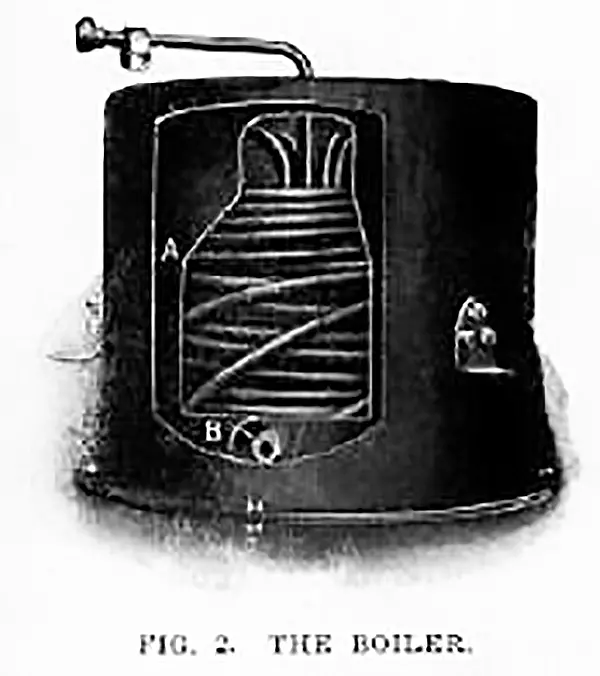 Automobile boiler
Automobile boiler
Driving early vehicles was dangerous. There were numerous valves, levers, and other controls that, if not set in their proper sequences, could send the car careening out of control. One unfortunate country doctor confused some levers when starting his Steamer, with the following result:
Thus given life and liberty the carriage gave a lunge, and throwing my frightened friend out on his head, made for the nearest house, which it bombarded with such a crash that the inmates thought the tenants of Dante's Inferno were let loose. The concussion threw back the reversing lever and away the vehicle went, like a pyrotechnic serpent, in the opposite direction, and fetching up against a portico made kindling wood of the greater part of it. Seemingly satisfied with its antics, it rebounded into the road, where it came to an unexpected standstill. It seems the last concussion had fortunately thrown the reversing lever to dead centre; hence the cessation of hostilities. We finally got in and returned home.
Difficult to operate in good conditions, the Steamer was often rendered useless in windy or cold conditions. Water lines froze, gas did not vaporize equally, and a good wind could snuff out the burner completely [open]. Dedicated drivers hired mechanics to travel with them and most found they had to fashion parts and modifications to keep their vehicles on the road. Getting a good head of steam up in a cold engine was an arduous task [open]. ´After a couple of hours I finally succeeded in getting the required amount of steam," wrote one novice driver, "but not until I had scorched my eyebrows and hands somewhat. . .”[open]
By September of 1901, two separate models of Toledo Steamers were entered in the first long- distance endurance road rally in U.S. history, from New York to Buffalo [open]. Although the race was cancelled en route due to the news that President William McKinley had been assassinated, a 6.5 hp Toledo, driven by H. Curtis and Grant Rollings, finished the race and earned a third-class certificate after averaging a whopping 4.21 mph. Pleased by Toledo's prospects, ABC announced a few months later that it was moving the headquarters of its automobile division from New York to Toledo and expanding its factory by a third.
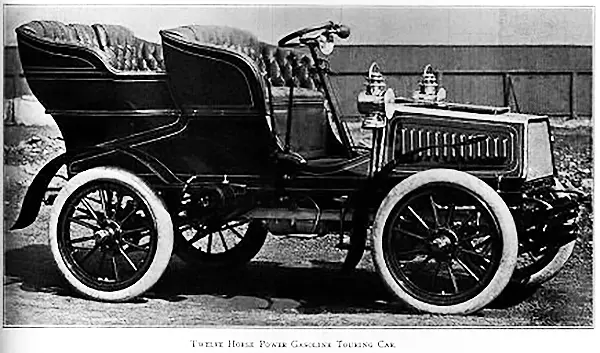 12 HP Toledo Gasoline Touring Car.
12 HP Toledo Gasoline Touring Car.
ABC debuted its new line of Toledo Steamers at the Madison Square Garden Auto Show in New York in 1901. Not only did it buy the largest space of any exhibitor at the show, but it conducted a number of publicity stunts. The company drove one of its carriages from Toledo to New York to attend the show. The trip took two weeks. Each day the drivers composed a tale of their adventures and progress and telegraphed it to New York, where they were posted by ABC's exhibit. To show off the rugged construction of its engine, a working model was to be installed at the show and revved up to a screaming 2200 rpms before suddenly engaging the reverse gear. The advertising paid off: trade journals gave the new cars much praise, especially those tortured engines that the leading automobile journal said were "put up in a very substantial and workmanlike manner" [open]
In 1902, the American Bicycle Company divested itself of its last bicycle holdings and changed its name to the International Motor Car Company. That same year, the Toledo plant began building its first internal combustion touring car, though it also continued to produce a line of Steamers. By the following year, however, the company abandoned the Steamer and began producing gas cars exclusively.
The gasoline engine, producing far more horsepower per pound of powerplant and enjoying a much larger range, also allowed for a bigger and heavier chassis. In 1903, the newly renamed ´Pope-Toledo´ took on its classic look - a sturdy, ruggedly built, open roadster with high, overstuffed seats. It was a luxury car popular among the country club set with a base price of nearly $3,000, several times the yearly income of most Americans. When Secretary of State Elihu Root needed automobiles to carry Russian and Japanese diplomats around Portsmouth, New Hampshire, during the important negotiations that ended the Russo-Japanese War, he ordered a dozen Pope-Toledos.
The heavier, more powerful Pope-Toledo also began to distinguish itself in the world of racing. In 1903, the Pope-Toledo won fifteen races and placed in twenty-nine others. The following year, Pope-Toledos made it to the winner's circle in thirty-three of the forty races they were driven in. It also became the first gasoline auto to climb Mt. Washington, the tallest peak east of the Mississippi.
The success of the Pope-Toledo soon encouraged imitation, and a pair of rival Toledo bicycle companies combined to give the Pope corporation a little competition. The Snell Fittings Company (perhaps the largest maker of bicycle parts in the U.S.) and the Kirk Manufacturing Company debuted their ´Yale´ automobile in in 1903. The Yale was produced for less than two years before the project was abandoned.
Toledo's Early Automobiles: 1900-1906 - Model List
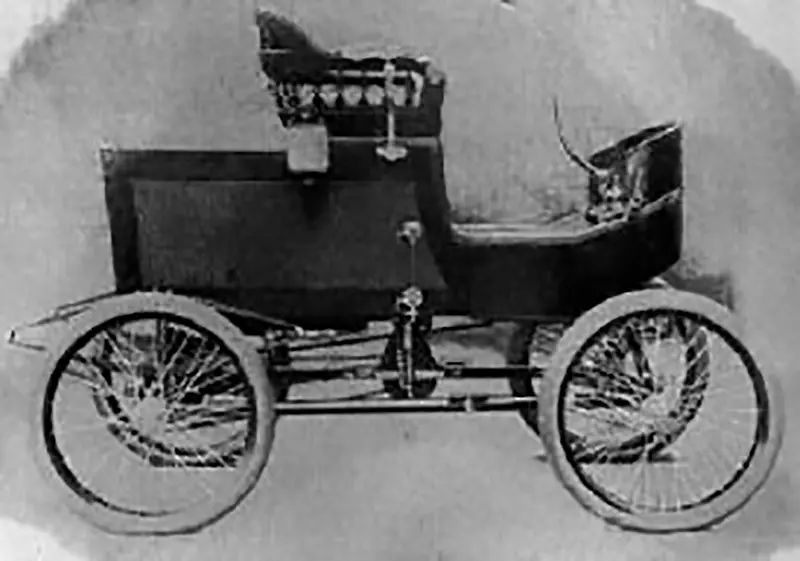 1900-1901 American Bicycle Co. "Toledo" Steam Automobile
1900-1901 American Bicycle Co. "Toledo" Steam Automobile
The Madison Square Garden Show (The Horseless Age, pp. 633-634) [PDF]
The Toledo Four-Ton Steam Truck (The Horseless Age, November 20, 1901, pp. 721-722) [PDF]
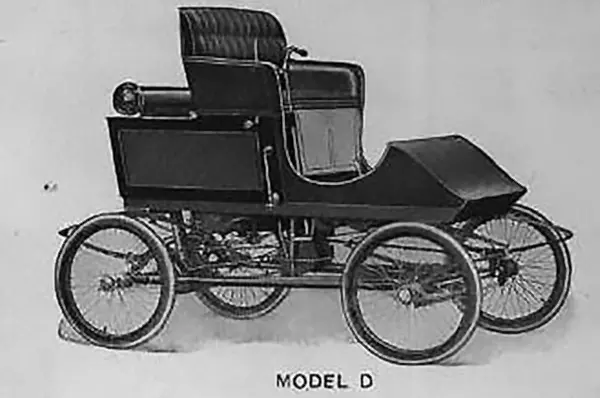 1901 Toledo Steam Carriage, Model D
1901 Toledo Steam Carriage, Model D
"Toledo" Steam Carriages [jpeg/image]
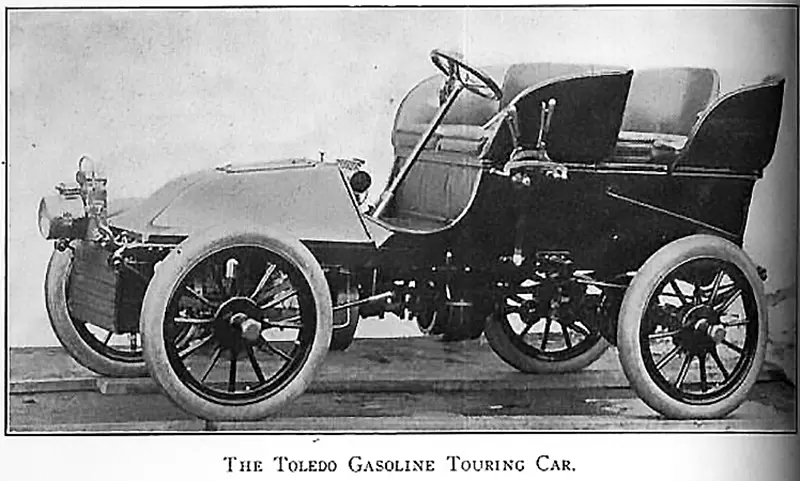 1902 Toledo Gasoline Touring Car
1902 Toledo Gasoline Touring Car
STEAM: The Toledo Touring Car (partial article, 1 p.)
"The Toledo Steam Carriage, Model D," (The Horseless Age, 4 pp.) [PDF]
 1903 Toledo Gasoline Touring Car
1903 Toledo Gasoline Touring Car
"New Vehicles and Parts" (The Horseless Age, April 22, 1903, Vol. II, no. 16,) [PDF]
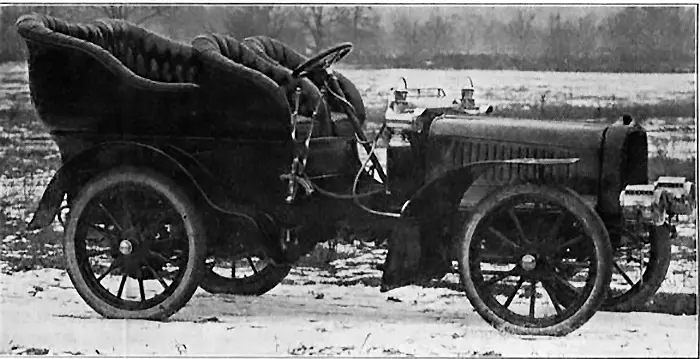 1904 4-cylinder Toledo Touring Car
1904 4-cylinder Toledo Touring Car
"New Vehicles and Parts" (The Horseless Age, February 10, 1904, Vol. 11, no. 16) [PDF]
The "Car De Luxe" (The Horseless Age, December 5, 1906, Vol. 18, no. 21) [PDF]
Toledo's Automotive Pioneers - Clipping File
The Early Experience of Driving
- "Antics of a Steam Carriage" by S. Q. Lapius (The Horseless Age, Dec. 26, 1900, p. 14 jpeg/image)
- "Three Month´s Use of a Steam Carriage" by a Country Doctor (The Horseless Age, Nov. 27, 1901, 5 pp., PDF)
- "Six Months With a Steam Carriage", by E. Miller (The Horseless Age, Jan. 1, 1902 , p. 28-29, PDF)
- "The Log of a Toledo from Toledo to Hot Springs, Ark." (The Horseless Age, Jan. 22, 1902 , p. 126, jpeg/image)
- "A Trip Through the Rockies (by Toledo steamer)" (The Automobile (New York), Feb. 1902, p. 50, jpeg.image)
- "The Steam Carriage in the Heavy Winds of the Plains" by James G. Blaine (a description of use of a Toledo in Kansas)" (The Horseless Age, Feb. 19, 1902 , 3 pp, PDF)
- "Toledo´s Use of Commercial Trucks (Illus.)" (The Horseless Age, July 5, 1905, pp. 30-31, PDF)
Competitions
- "The New York-Buffalo Endurance Run" (the Toledo steamers´ first competition), Sept. 1901 (The Horseless Age, Sept. 11, 1901, 20 pp., PDF)
- "The New York-Buffalo Endurance Run" (the Toledo steamers´ first competition), Sept. 1901, part two. (The Horseless Age, Sept. 18, 1901, p. 509-510, PDF)
- "Impressions of the New York-Buffalo Endurance Contest" by Albert L. Clough" (The Horseless Age, Sept. 18, 1901, p. 512-514, PDF)
- "Some Things Lacking (criticism of the Buffalo-New York race) by C.C. Bramwell" (The Horseless Age, Sept. 18, 1901, p. 516, PDF)
- "The New York-Buffalo Endurance Run: The Third Stage [note Pope interviewed on page 27]" (The Horseless Age, Sept. 18, 1901, 27 pp., PDF)
- "Record of the Toledo in Endurance Run," a letter from W.C. Stuart (The Horseless Age, Oct. 2, 1901, p. 568, jpeg/image)
- ´'Deeds of the Record Breakers" (Toledo wins Grosse Point races), 1901 (The Horseless Age, Oct. 16, 1901, p. 600, PDF)
- "Official records of the New York-Buffalo Endurance Race" (The Horseless Age,Oct. 16, 1901, 3 pp., PDF)
- "Table of results from the Long Island Endurance Race (two of the twenty-two blue ribbons awarded go to Toledos)." (The Horseless Age, Apr. 30, 1902 , p. 542,jpeg/image)
- "Sixty H.P. Pope-Toledo Racer" (The Horseless Age, June 29, 1904 , p. 681, jpeg/image)
- "The Vanderbilt Cup Race (Illus.)" (The Horseless Age, Oct. 12, 1904 , p. 378-380, PDF)
The Toledo Steamers
- ´The New Toledo Steam Carriage´, 1901." (The Horseless Age, July 24, 1901, p. 361, PDF)
- Photo of the Toledo Steam Carriage, July 1901" (The Horseless Age, July 24, 1901, p. 361, jpeg/image)
- The Toledo steamers at the Madison Square Garden Auto Show" (The Horseless Age, Oct. 16, 1901, 2 pp., PDF)
- Description of the steam vehicles at the Madison Square Garden Auto Show. (ABC sold 36 autos during the show; Winton over 100)" (The Horseless Age, Nov. 6, 1901, p. 672-673, PDF)
- Table of Data of Steam Vehicles Displayed at Madison Square Garden Auto Show, Nov. 1901" (The Horseless Age, Nov. 20, 1901, p. 734, jpeg/image)
- "The Toledo Steam Carriage Model D. (Illus.)" (The Automobile (New York), Jan. 1902, p. 7-8, PDF)
- "Advertisement for the 1902 ´Toledo"´ Steam Carriage" (The Automobile (New York), Jan. 1902, p. 8, jpeg/image)
- International Motor Car Company´s Exhibit at Chicago" (The Horseless Age, Feb. 12, 1902 , p. 220, jpeg/image)
- "Advertisement for the International Motor Car Co., makers of the Toledo steamers." (The Automobile (New York), Feb. 1902, p. 31, jpeg/image)
- "Advertisement for the International Motor Car Co., makers of the Toledo steamers." (The Automobile (New York), May. 1902, p. 158, jpeg/image)
- "Some Features of the (1902) Toledo Steam Carriage (illus.) Part One." (The Horseless Age, Apr. 16, 1902, 5 pp., PDF)
- "The Twelve Horse Power Toledo Gasoline Touring Car (1903) (Illus.)" (The Horseless Age, Apr. 22, 1903 , 4 pp., PDF)
- "Some Features of the (1902) Toledo Steam Carriage (illus.) Part Two." (The Horseless Age, Apr. 23, 1902 , p. 494-496, PDF)
- Advertisement for the Toledo Steam Carriage, Dec. 1901." (The Horseless Age, Dec. 25, 1901, p. 111, jpeg/image)
- Photo of the Toledo Steam Carriage, Model D, circa 1901." (The Horseless Age, Dec. 25, 1901, p. 111, jpeg/image)
- The ´Toledo´ Steam Carriage - a description from the Horseless Age, Dec. 1900" (The Horseless Age, Dec. 26, 1900, p. 14, jpeg/image)
- "Photo of a Toledo Steamer in use over rough Kansas roads." (The Horseless Age, Feb. 19, 1902 , p. 252, jpeg/image)
- Advertisement for the ´Toledo´ Steam Automobile" (The Horseless Age, Feb. 20, 1901, p. 9, jpeg/image)
- "Some Features of the Toledo (steam car), Jan. 1902." (The Horseless Age, Jan. 8, 1902 , 4 pp, PDF)
- "The (1902) Toledo (steam) Touring Car" (The Horseless Age, Mar. 12, 1902 , p. 327-328, PDF)
- "Photo of the 1902 Toledo (steam) Touring Car." (The Horseless Age, Mar. 12, 1902 , p. 327-328, jpeg/image)
- Advertisement for the ´Toledo´ Steam Automobile" (The Horseless Age, Mar. 13, 1901, p. 9, jpeg/image)
- New Toledo Dos-a-Dos (1902) (Illus.)" (The Horseless AgeThe Horseless Age, June 25, 1902 , p. 765, jpeg/image)
- "Photo of the 1902 Toledo Dos-a-Dos " (The Horseless Age, June 25, 1902 , p. 765, jpeg/image)
- "´The Toledo Four-Ton Steam Truck´" (The Horseless Age, Nov. 20, 1901, p. 721, PDF)
- ´The Toledo Junior´: a late entry to the Madison Square Garden Auto Show" (The Horseless Age, Nov. 20, 1901, p. 722, jpeg/image)
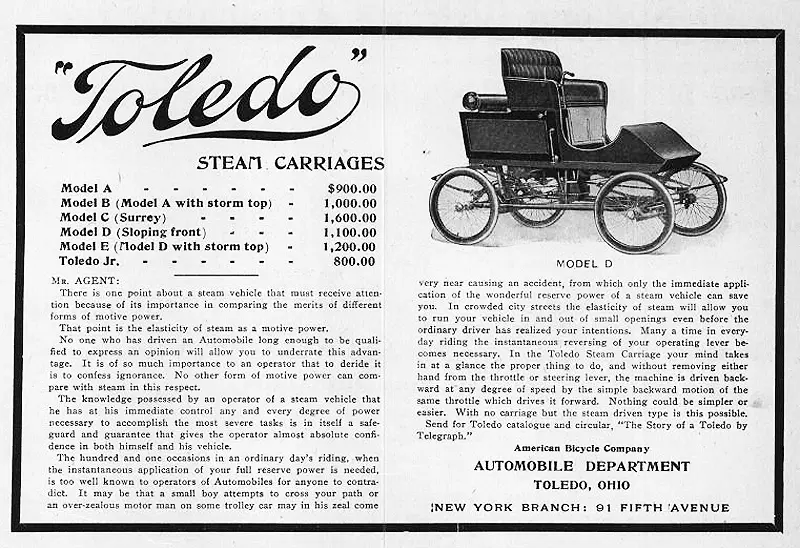 Toledo Steam Carriage Model D ad
Toledo Steam Carriage Model D ad
The Gasoline Toledos
- "The (1904) Pope-Toledo Four Cylinder Touring Car (Illus.)" (The Horseless Age, Feb. 10, 1904 , p. 165-166, PDF)
- The Sixteen Horse Power Toledo Gasoline Touring Car (Illus.)" (The Horseless Age, Aug. 20, 1902 , p. 201, jpeg/image)
- "Schematic sideview of Toledo Gasoline Touring Car (1902)" (The Horseless Age, Aug. 20, 1902 , p. 201, jpeg/image)
- "Schematic topview of Toledo Gasoline Touring Car (1902)" (The Horseless Age, Aug. 20, 1902 , p. 201, jpeg/image)
- "New Vehicles and Parts: The 1905 Pope-Toledo" (The Horseless Age, Apr. 5, 1905 , p. 411-413, PDF)
- The Toledo Throttle (Illus.)" (The Horseless Age, Aug. 6, 1902 , p. 141, jpeg/image)
- "The Pope-Toledo Model XV (Illus.)" (The Horseless Age, Sept. 26, 1906, p. 379-381, PDF)
- The Toledo Three Cylinder Motor (Illus.)" (The Horseless Age, Sept. 3, 1902 , p. 258, PDF)
- The Transmission Gear of the Toledo Gasoline Touring Car (Illus.)" (The Horseless Age, Sept. 17, 1902 , p. 305-306, PDF)
- "A photo of the 1902 Toledo Gasoline Touring Car." (The Horseless Age, Mar. 12, 1902 , p. 324, jpeg/image)
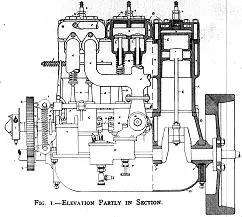 The Toledo Three Cylinder Motor
The Toledo Three Cylinder Motor
Other Early Toledo Auto Makers
- "The ´Car De Luxe" (Illus.) (The Horseless Age, Dec. 5, 1906 , p. 823-824, PDF)
- "The Craig-Toledo Touring Car (Illus.)" (The Horseless Age, Dec. 5, 1906 , p. 830-831, PDF)
- "New (1905) Yale Models (Illus.)" (The Horseless Age, Jan. 11, 1905 , p. 47-48, PDF)
- "Advertisement for the Yale 4 cylinder." (The Horseless Age, July 5, 1905 , p. lxi, PDF, jpeg/image)
Patents and Inventors
- Patent 657,643 - Lubricator for Engine Cylinders by George A. Burwell of Toledo, Sept. 11, 1900" (The Horseless Age, Sept. 26, 1900, p. 24, jpeg/image)
- Patent No. 702,410 for an ´Engine Controlling Mechanism´ filed Dec. 19, 1901, by Otto F. Dannenberg and Ralph L. Morgan, of Toledo, Ohio, awarded June 17, 1902." (The Horseless Age, June 25, 1902 , p. 771, jpeg/image)
- Patent no. 680,899 - Automobile by Alfred Thompson, Aug. 20, 1901" (The Horseless Age, Sept. 4, 1901, p. 486, jpeg/image)
- "'Engine Control by Dilution of Charge with Inert Gases' by H.P. Dodge of Toledo." (The Horseless Age, Apr. 2, 1902 , p. 425, jpeg/image)
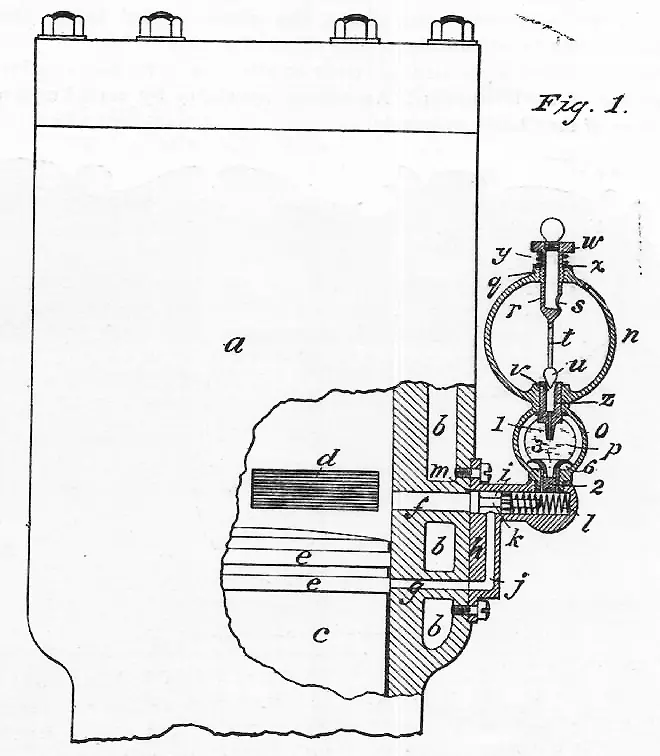 Drawing of Patent 657,643 - Lubricator for Engine Cylinders by George A. Burwell of Toledo, Sept. 11, 1900
Drawing of Patent 657,643 - Lubricator for Engine Cylinders by George A. Burwell of Toledo, Sept. 11, 1900
The Automotive Industry and Misc.
- ´International Motor Car Company´s Testing Methods´" (The Horseless Age, Jan. 22, 1902 , p. 119-120, PDF)
- The ´Simplex´ and ´Multiplex´ Lubricators for Gasoline Vehicles (made by the Automatic Lubricator Company of Toledo, Ohio)" (The Horseless Age, June 18, 1902 , p. 742-743, jpeg/image)
- "´Brake Tests Under the Auspices of the A.C.A.´ (includes table of braking performance for 1902 Toledo steamers). (Illus.)" (The Horseless Age, May 7, 1902 , p. 565-566, PDF)
- Production statistics for leading automobile manufacturers for 1901." (The Horseless Age, Nov. 13, 1901, p. 709, jpeg/image)
- New Vehicle Tax Law for Toledo, Ohio" (The Horseless Age, Oct 5, 1904 , p. 350, jpeg/image)
- The Toledo Automobile Club" (The Horseless Age, Oct. 8, 1902 , p. 394, jpeg/image)
- The (founding of) the Toledo Automobile Club" (The Horseless Age, Sept. 17, 1902 , p. 308, jpeg/image)
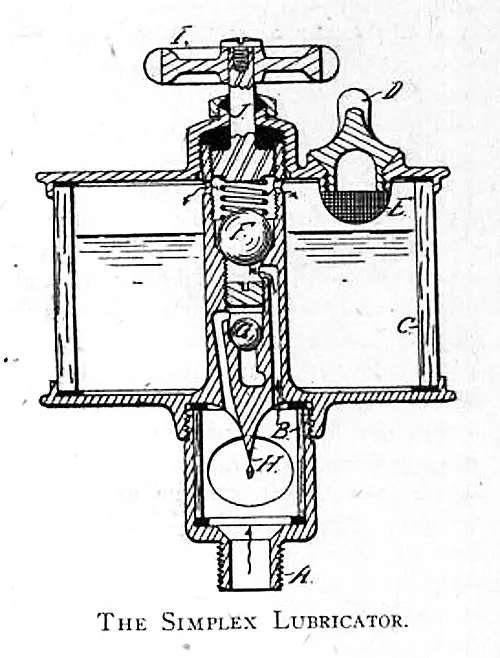 Simplex Lubricator for Gasoline Vehicles
Simplex Lubricator for Gasoline Vehicles
Chronology of Automobile Manufacturing in Toledo, Ohio
1898 - A plumber by the name of A.E. Lecklider began construction of an automobile in his spare time. He completed it in 1902 but saw it destroyed by fire the following year. Lecklider began again and built an improved gasoline automobile that reportedly had a single piston which put out 6 h.p. His achievement was reported in a 1906 issue of The Motor Way.
1899 - Apr.: George Burwell, superintendent of the Lozier Bicycle factory, designed a 3-wheeled gasoline car with John G. Perrin. When Lozier sold out to the American Bicycle Co., the tricycle was sold as well. Burwell and Perrin would go with Lozier to build the famous Lozier automobile.
- Sept.: Peter Gendron brings to Toledo the second gas-powered automobile to drive over the city streets.
1900 - The Co-operative Wheel Co. organized in Toledo with $5,000 capital
- Sept.: Patent 657,643 - Lubricator for Engine Cylinders awarded to George A. Burwell of Toledo
- Dec.: The ‘Toledo’ Steam Carriage - a description from the Horseless Age, Dec. 1900
1901 - May: Lamson Brothers, a large department store in Toledo, Ohio, orders a steam delivery wagon. They formerly experimented with electricity for this purpose.
- Aug: Patent no. 680,899 - for an "Automobile" awarded to Alfred Thompson, Aug. 20, 1901
- Sept: Two Toledo steamers, one class B (1,000 to 2,000 pounds), and one class E (public delivery vehicles), are entered by the American Bicycle Co. in the New York- to-Buffalo Endurance Contest of mid-September of 1901. There are 36 cars in class B and three in class E.
- Oct: A Toledo wins the Grosse Point races.
- Oct: The headquarters of the automotive division of the American Bicycle Co. is moved from New York to Toledo. Also, the American Bicycle Company announces that their Toledo, Ohio factory will shortly be increased in size by one third its present capacity. Commencing the early part of next year there will be manufactured at this factory, in addition to the Toledo steam carriages, steam trucks, street cleaners and gasoline vehicles. The plans for these various vehicles are still in the draughting room and the company is not yet prepared to give full information about them.’
- Oct: “An ordinance to limit the speed of automobiles in Toledo to 6 miles an hour reached the second reading and was then dropped altogether as a piece of inoperative and useless legislation.”
- Nov: “The Toledo steam carriage which was dispatched from Toledo, Ohio, about two weeks before the Madison Square Garden auto show reached its destination in time. It covered the distance in easy stages of 60 to 70 miles per day and telegrams from the various stopping places en route were exhibited on a frame at the show, telling the story of the trip.”
1902 - Kirk Manufacturing Co. of Toledo announces its plans to build cars in 1899. It did not actually begin production until 1902, when it teamed up with another large bicycle manufacturer, the Snell Manufacturing Co., and built the ‘Yale’ car until 1905.
- Jan: Toledo, Ohio adlermen propose to tax pleasure automobiles at the rate of $5 a year and business automobiles at the rate of $10 a year. (A vehicle luxury tax would finally pass in 1904).
- Jan: The Toledo Bee buys a Winton wagon for newspaper delivery.
- Feb.: “Reports from Flagstaff, Ariz., state that Oliver Lippincott, the Los Angeles artist, in his ‘Toledo’ climbed ‘Knob Hill,’ a 16 per cent grade in 6 inches of snow, in a test before a committee of the new automobile company, which will operate between Flagstaff and the Grand Canyon. The new company expects to have fifteen stages running by May 1.”
- Feb.: "C.E. De Long, of Hot Springs, Ark., and J.E. Saules, of Toledo, Ohio, who started from Toledo in a ‘Toledo’ steam carriage the day before Christmas, are reported to have reached Little Rock, Ark., on the 6th, having been compelled to take the train from Memphis to Hot Springs in consequence of the heavy rains which had flooded the Mississippi bottoms and made the roads impassable. They remained in Little Rock until February 10, when they proceeded on their way by automobile."
- April 30: Patent No. 697,099 awarded Apr. 8, 1902 to Ralph L. Morgan of Toledo for a “Pump for vehicles.” Morgan filed his claim on Jan. 16, 1902.
- May: Toledo had one of its first automobile fatalities in 1902 when a little girl was struck and killed by an auto while riding her bicycle.
- June: Patent No. 702,410 for an ‘Engine Controlling Mechanism’ filed Dec. 19, 1901, by Otto F. Dannenberg and Ralph L. Morgan, of Toledo, Ohio, awarded June 17, 1902.
- Aug. 6: “Toledo, Ohio, claims to be leading cities of its size in the country as regards popularity of the automobile. The number of vehicles owned there is said to be eighty-eight.”
- Sept: The Toledo Automobile Club is founded.
1903 - On July 25, 1903, Arthur C. Moses became the first man to drive a gas powered automobile to the top of Mount Washington, New Hampshire (the highest point in the U.S. east of the Rocky Mountains). He drove a 24-horsepower Toledo. His climb took 3 hours and 5 minutes. F.O. Stanley accomplished the same feat four years earlier, but in a steam-powered machine, the famous “Stanley Steamer.”
1904 - Oct: New vehicle tax law passes in Toledo.
1906 - Jan.: Cooney & Company founded ($10,000 capital) by the Cooney Carriage Co. and Albert F. Clark. Charles R. Bowman was made president, James J. Cooney, v.p., George L. Shanks, g.m.. The company aimed to produce an electric vehicle of standard chassis and interchangeable body. A prototype was running by Feb. of 1907.
- March 1: a prototype gasoline car, called the “Maumee,” built in Dundee, Mich. by the Craig-Toledo Co., unveiled. The car was designed by Frank M. Blair (who also worked for Ford for a time) and financed by George and John Craig, Toledo shipbuilders. Blair patented the Maumee's three-point suspension. In Jan. of 1907 the car began being widely advertised for $4,000. Production ran for six months until the company failed in Feb. of 1907.
- From 1906 and into 1907, the De Luxe Motor Car Co. of Toledo, Ohio builds the 'Car De Luxe' car in the old Yale Bicycle Co. factory. In October, President Nathan M. Kaufman, and General Manager Daniel W. Kaufman, merges with C.H. Blomstrom of Detroit. By late 1907 this car's production had moved to Detroit and came to an end in 1909.
- Nov.: American Juvenile, made by Am. Metal Wheel & Auto Co. debuts at NYC auto show. The Am. Juvenile made until 1907.
1909 - Jan.: Richard D. Apperson of Lynchburg, VA. makes bid for the Pope Motor Car Co.
- F.E. Bissell purchases the rights to manufacture an electric vehicle and produces one prototype.
- Albert F. Clark founds Allen & Clark Electric Co. to produce an electric car.
1910 - May S.W., M.G., F.X. and R. Dusseau incorporate the Dusseau Fore and Rear Drive Automobile Company with $30,000 capital. Dr. Dusseau patents a four wheel drive system. In Nov. the company completes its first experimental car. In December it displays the car in a showroom on Erie St. In January 1911, the company shows it off at the Detroit Auto Show. It is not known how many were built. In 1913, the Dusseaus try to launch a Dusseau truck company with unknown results.
1911 - Spring.: Clarence D. Pettingell, James Samsen, Fred H. Kruse, Mark Winchester, and William J. Frische, incorporate the Interstate Supply Company ($10,000 capital) to build an automobile and various parts. It is doubtful that they succeeded.
1912 - Late spring.: C.H. Dennis, C.W. Close, Allen L. Reid, and R.S. Woodrow found the Dennis Motor Company with capital of $25,000 to make autos and engines. It is unknown if they ever manufactured any.
1913 - Nov.: The Carl Electric Vehicle Co. is founded by Arnold Goss, A.O. Garford, H. Sulzberger, and C.A. Neracher, the last being the chief engineer of Willys-Overland. Though capitalized at three hundred thousand dollars, the firm only manages to produce a few prototypes before going belly up.
1914 - Sept.: W.S. Hyslop and H.W. Clark announce plans to produce a cycle car that would retail at $425. A prototype was probably built but that is as far as their plans went.
1917 - A.T. Wilson, R.W. Beaschler, and Andrew A. Lehr (formerly of Pope-Toledo) organize the Belmont Motor Co. of Toledo. Lehr designs a car he calls the Belmont Six and a prototype is in operation by March. The automobile is advertised in May of that year.
1920 - The Cyclomobile Manufacturing Co. founded by Charles D. Hamel to produce a lightweight car. It has an air-cooled engine, a chain drive, and a friction transmission. Two versions are produced, a two-seater, called the 'Cyclomobile,' and a longer wheelbase with a rear deck for deliveries called the 'Manexall.' It fails by 1921.
1930 - J.W. Harruff of 193 Woodruff Ave., builds the 'Harruff,' a 20 hp., 80-inch wheelbase car that resembled the Whippet. He built it for himself and did not intend to mass produce it. Harruff was profiled in the Automobile Trade Journal.
Toledo's Early Automobiles: 1900-1905 - Advertising Gallery
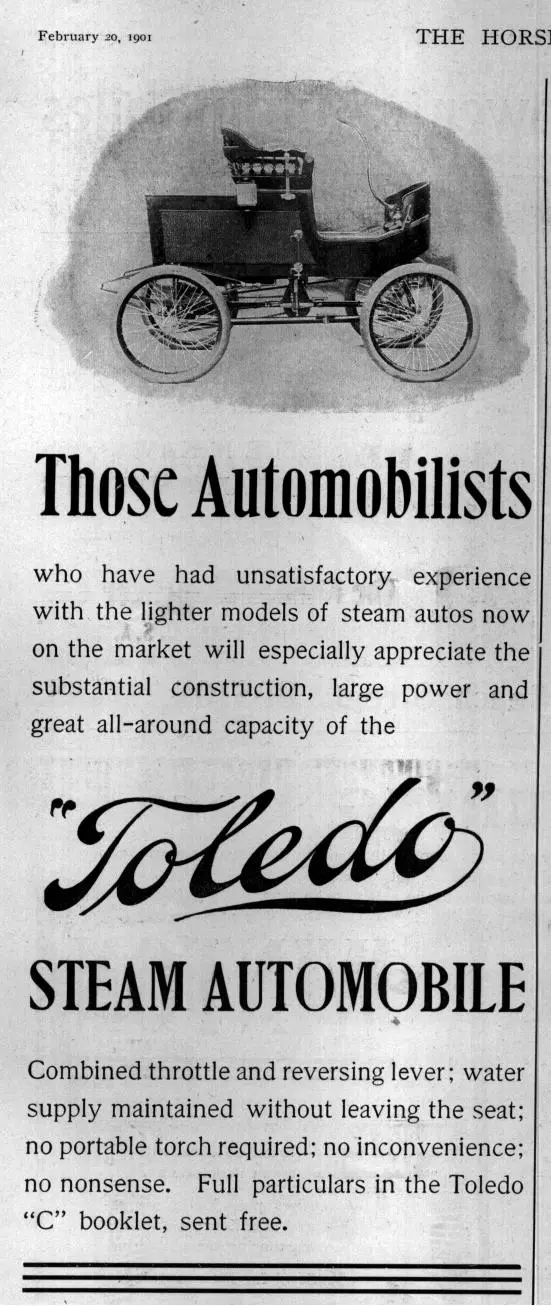 Advertisement for the Toledo Steam Automobile (The Horseless Age (New York), Feb. 20, 1901, p. 9)
Advertisement for the Toledo Steam Automobile (The Horseless Age (New York), Feb. 20, 1901, p. 9)
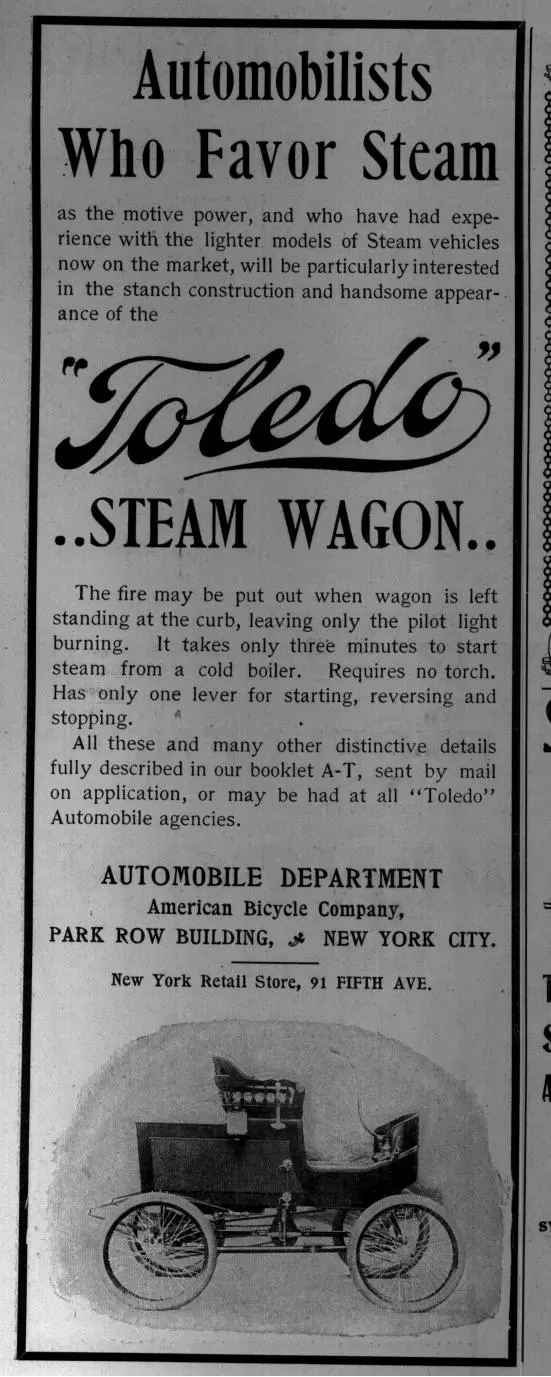 Advertisement for the Toledo Steam Automobile(The Horseless Age (New York), March 13, 1901, p. 9)
Advertisement for the Toledo Steam Automobile(The Horseless Age (New York), March 13, 1901, p. 9)
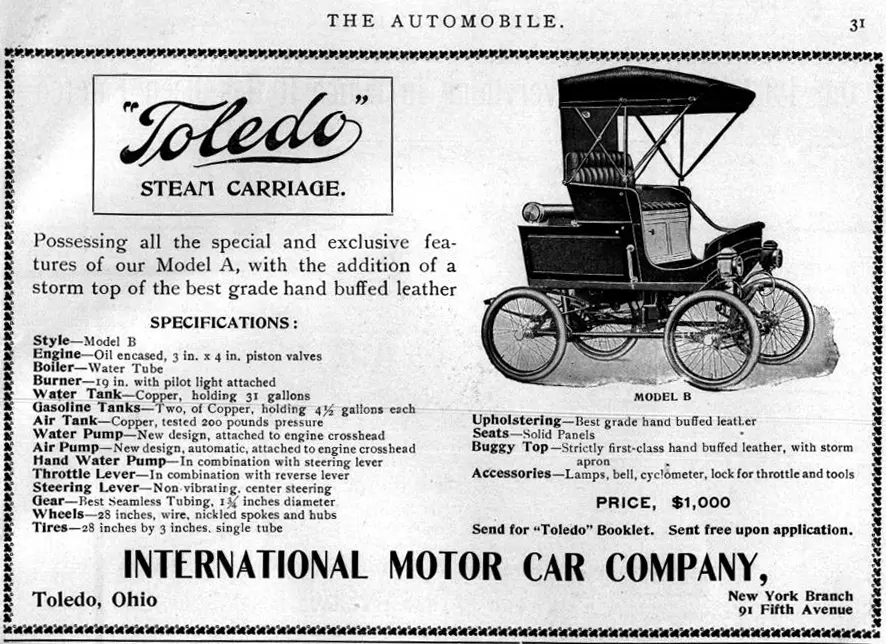 "Advertisement for the 1902 ´Toledo"´ Steam Carriage" (The Automobile (New York), Jan. 1902, p. 7-8)
"Advertisement for the 1902 ´Toledo"´ Steam Carriage" (The Automobile (New York), Jan. 1902, p. 7-8)
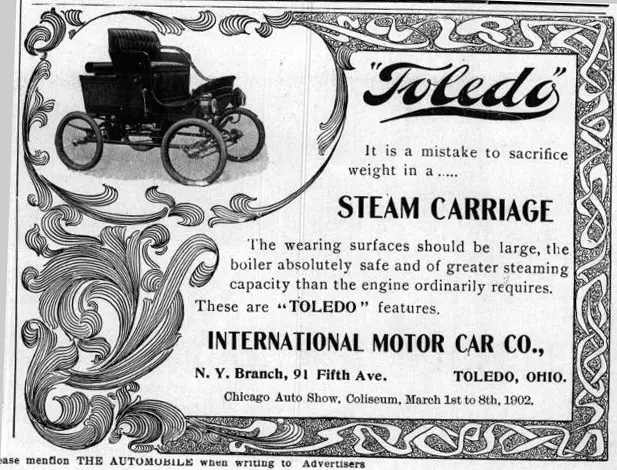 "Advertisement for the International Motor Car Co., makers of the Toledo steamers." (The Automobile (New York), Feb. 1902, p. 31)
"Advertisement for the International Motor Car Co., makers of the Toledo steamers." (The Automobile (New York), Feb. 1902, p. 31) 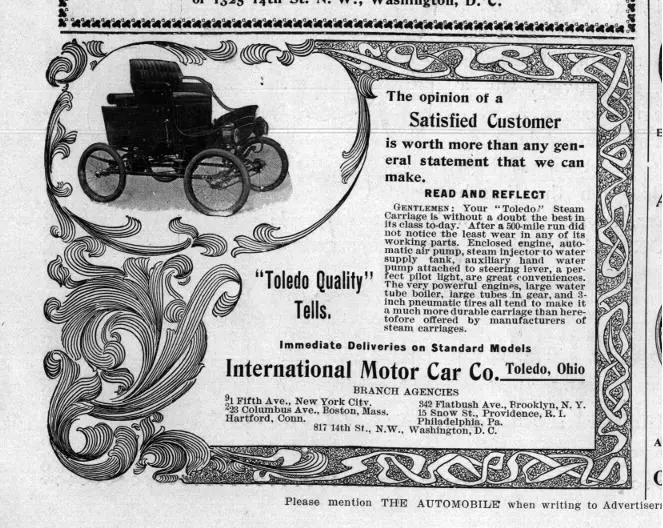 "Advertisement for the International Motor Car Co., makers of the Toledo steamers." (The Automobile (New York), May. 1902, p. 158)
"Advertisement for the International Motor Car Co., makers of the Toledo steamers." (The Automobile (New York), May. 1902, p. 158)  "Advertisement for the Toledo Steam Carriage, Dec. 1901." (The Horseless Age, Dec. 25, 1901, p. 111)
"Advertisement for the Toledo Steam Carriage, Dec. 1901." (The Horseless Age, Dec. 25, 1901, p. 111)
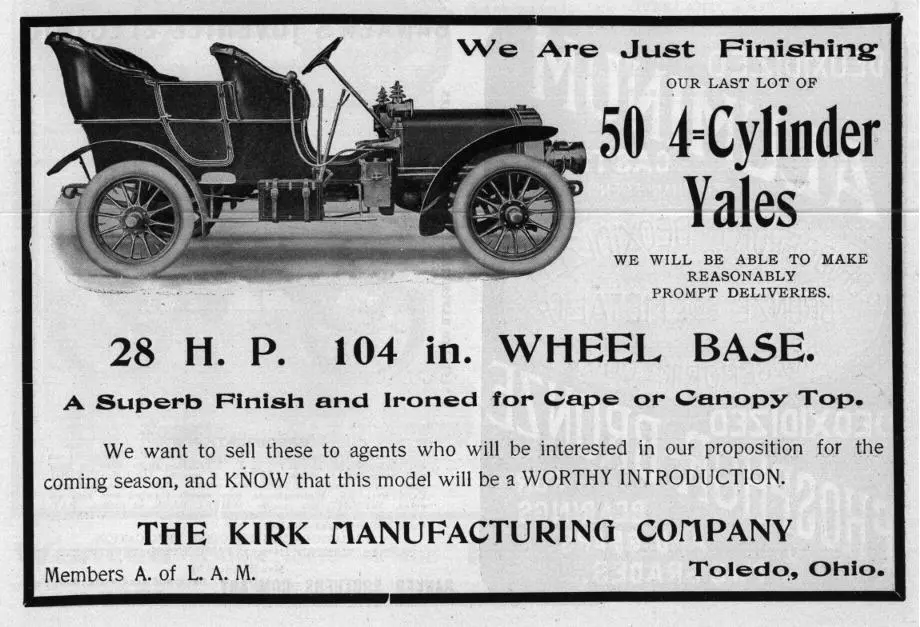 Advertisement for the ´Yale´ 4 cylinder (The Horseless Age, July 5, 1905 , p. lxi)
Advertisement for the ´Yale´ 4 cylinder (The Horseless Age, July 5, 1905 , p. lxi)
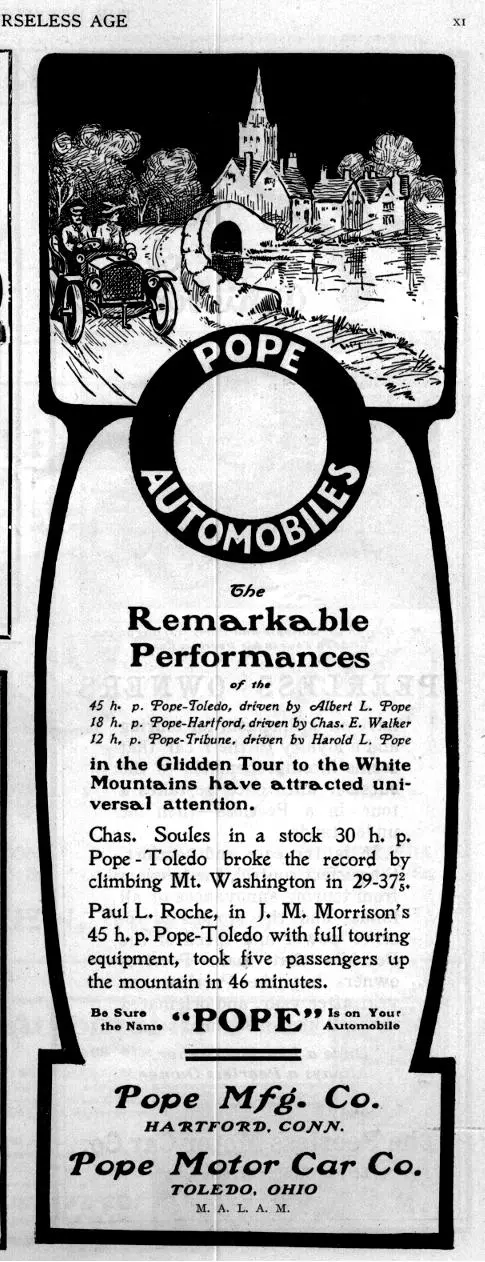 Advertisement for the Pope-Toledo Company (The Horseless Age, Aug. 9, 1905, p. xi.)
Advertisement for the Pope-Toledo Company (The Horseless Age, Aug. 9, 1905, p. xi.)
Advertisement for the Pope-Toledo Company (The Horseless Age, Aug. 9, 1905, pp. viii-ix.)
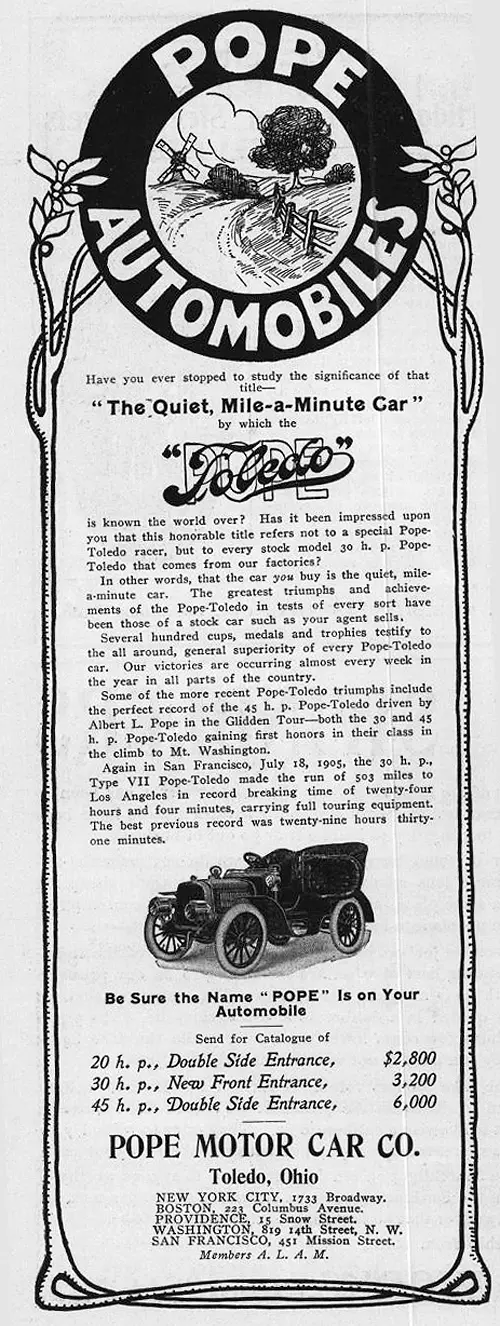 Advertisement for the Pope-Toledo Company (The Horseless Age, Sept. 20, 1905, p. xi.)
Advertisement for the Pope-Toledo Company (The Horseless Age, Sept. 20, 1905, p. xi.)

